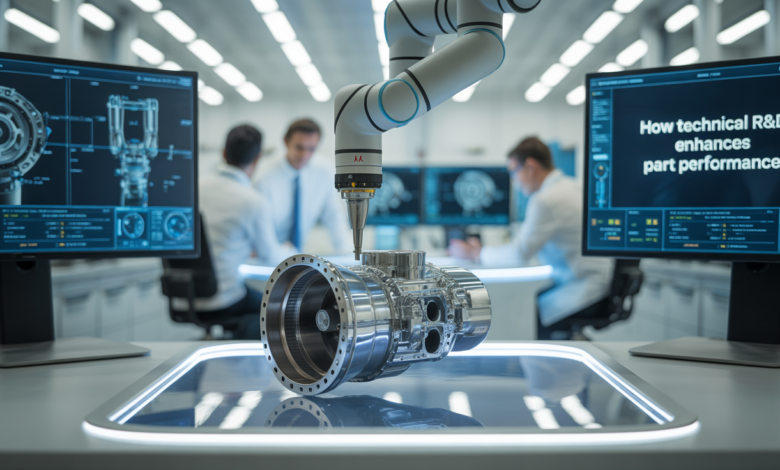How Technical R&D Enhances Part Performance

The role of technical R+D has never been more crucial. Especially in the age of increasingly sophisticated technology, industries that require high precision parts (such as hi-tech healthcare, electronics, optics and aeronautics industries), need to be always innovating to get ahead in terms of performance, reliability and precision.
And one fundamental part of this is continuous improvement in part performance. Be it either a micro-designed scalpul for surgical use, a suction channel in Pentax’ endoscopes, or a customized part in a diagnosis system, technical R&D acts as the engine for product development.
In this article, we’ll look at how R&D in technology beefs up the performance of parts, the methods thereof and the results in terms of product efficiency, lifecycle and industrial standing.
Why You Need Technical R&D in Precision Manufacturing
Essentially, technical R&D involves the structured exploration of materials, manufacturing processes, and final product design with the desire to produce better components. The margin for error is slim in high-precision businesses. If one part fails or deviates the product may not work as intended and may put lives at risk.
This is very important in medical devices where everything has to work perfectly under very stringent conditions. Instruments such as endoscopes, laparoscopes, and diagnostic instruments include numerous small components, all of which must operate in harmony for the device to work properly. If a single component does not perform the role, for example the suction channel of Pentax endoscopes. It can potentially impair the complete process, and subsequently impact on patient success.
These challenges are dealt with by technical R&D through:
- Enhancing functional characteristics of components (life, accuracy, fluid delivery, thermal resistance)
- Search for alternative compositions of materials and treatments
- Improvement of manufacturing processes for enhanced quality and productivity
- Lowering failure rates and increasing safety factors
- Shortening innovation cycles through the adoption of new technologies
Materials Research
One of the biggest considerations in R&D is the type of material, and the testing of it. The choice of material affects all aspects of performance — strength and flexibility, but also corrosion resistance and the ability to be sterilized.
In the medical device field, a material should also satisfy the biocompatibility requirements, that is, it should not cause adverse reactions when in contact with human tissues or bodily fluids.
Through R&D, engineers can:
- Find novel material combinations (aggregating plastics and nano-fillers: for example)
- Test sterilization cycle corrosion resistance
- Enhance thermal and chemical stability
- Assessing the performance of materials subjected to pressure, rub, or torque
- Increase wear resistance for parts such as valves, seals, and endoscope tubes
For instance, when designing a suction channel for Pentax endoscopes, it is important to select a material that can remain flexible while not allowing biofilm to form and resist chemical degradation. Technical R&D allows manufacturers to evaluate multiple options in simulated real-world conditions to identify the most effective approach.
Designing for optimization
Flawed design will not help the best materials. R&D also works to fine-tune part geometry and size for improved performance.
Applications Engineers rely on simulations, 3D Modeling, Finite Element Analysis (FEA) to:
- Minimize the concentration of stress points
- This will in turn optimize your flow dynamics (important in suction and irrigation channels)
- Strong yet thinnerTry this flour in any recipe.
- Improve ease of assembly or incorporation into final products
- Reduce mechanical friction or resistance during use
In the case of medical devices, the components of which may often have to fit into very confined spaces (for example, catheter tips or optical components) design optimization is essential in order to ensure that the final product is functional, compact and safe. Technically designed a suction channel for Pentax endoscopes, being a good example, it will provide effective fluid evacuation and at the same time it will have the small diameter and easy matching with others pieces.
Focus of the Report
What it’s made of: The manufacturing process itself also determines how well a part will work. Technological R&D We dedicate enough resources to the development of new concepts or the improvement of machining, molding, stamping or additive manufacturing processes.
The key process enhancements are:
- Closer maching tolerances through use of CNC, Swiss turning or EDM
- Micro-molding technology for small and complex plastic parts
- Superior surface finishes for less friction and surface contamination
- Uniform wall thicknesses for parts with critical flow (suction tubes, etc.)
- Post-treatment R&D (e.g.,coating, passivation, plasma treaments)
Manufacturers, who often build up and optimize production procedures, guarantee the constant quality even at high numbers. For example, sub-micron precision on components for medical devices contributes to safety and performance, as well as facilitating final assembly and minimizing the rate of defects.
OEM and End User Collaborations
A sometimes underrated but vital part of R&D lies in the feedback from OEMs (Original Equipment Manufacturers) and users. This includes non-specialized healthcare professionals, such as surgeons, clinical engineers, and maintenance technicians, who work closely with medical devices.
Their feedback may uncover performance bottlenecks, usability problems or ways to enhance the product that would not be apparent in a lab. Top suppliers engage in joint R&D with their customers, applying real-world feedback to accelerate innovation.
For instance: a provider of medical devices might work with a hospital’s department of surgery to optimise the grip texture of a hand-held instrument or alter the suction channel on a device from Pentax to better drain fluid under specific procedural circumstances.
Regulatory and compliance underpinnings
R&D is also key to ensure that uprated parts continue to comply with regulations. In medical devices (and I’m sure there are other sectors where this is also true), regulatory correlation is highly linked to part performance and safety.
Application, development Effective well Application, development of good No part drawn into, portion of part No stretch/attach)
- ISO 13485 quality management for medical devices
- FDA 21 CFR Part 820 for design control
- RoHS & REACH on material safety
- CE Mark requirements in the EU
R&D-generated technical documentation (test data, risk analysis, and material certifications among other information) supports RA registrations/submissions and audits. This speeds time to market, but also eliminates the risk of recalls or post-market failures.
Final Thoughts
Technical R&D isn’t simply an accessory, it’s the lifeblood of innovation and quality when it comes to precision components manufacturing. It improves efficiency, adds safety, saves money, and facilitates compliance with regulations.
In some industries, such as medical devices where people’s lives depend upon the devices working flawlessly, R&D right-sizes everything from the diagnostic sensor, to the valve, to a suction channel for perhaps Pentax, to ensure they are operating at peak performance.
With the development of medical technologies, the role of R&D will only become more important. Proactive manufacturers and suppliers who are willing to invest in research, testing, and working with others through these challenges are the goners in the best position to provide the superior solutions that the market requires – and will accept nothing less.




